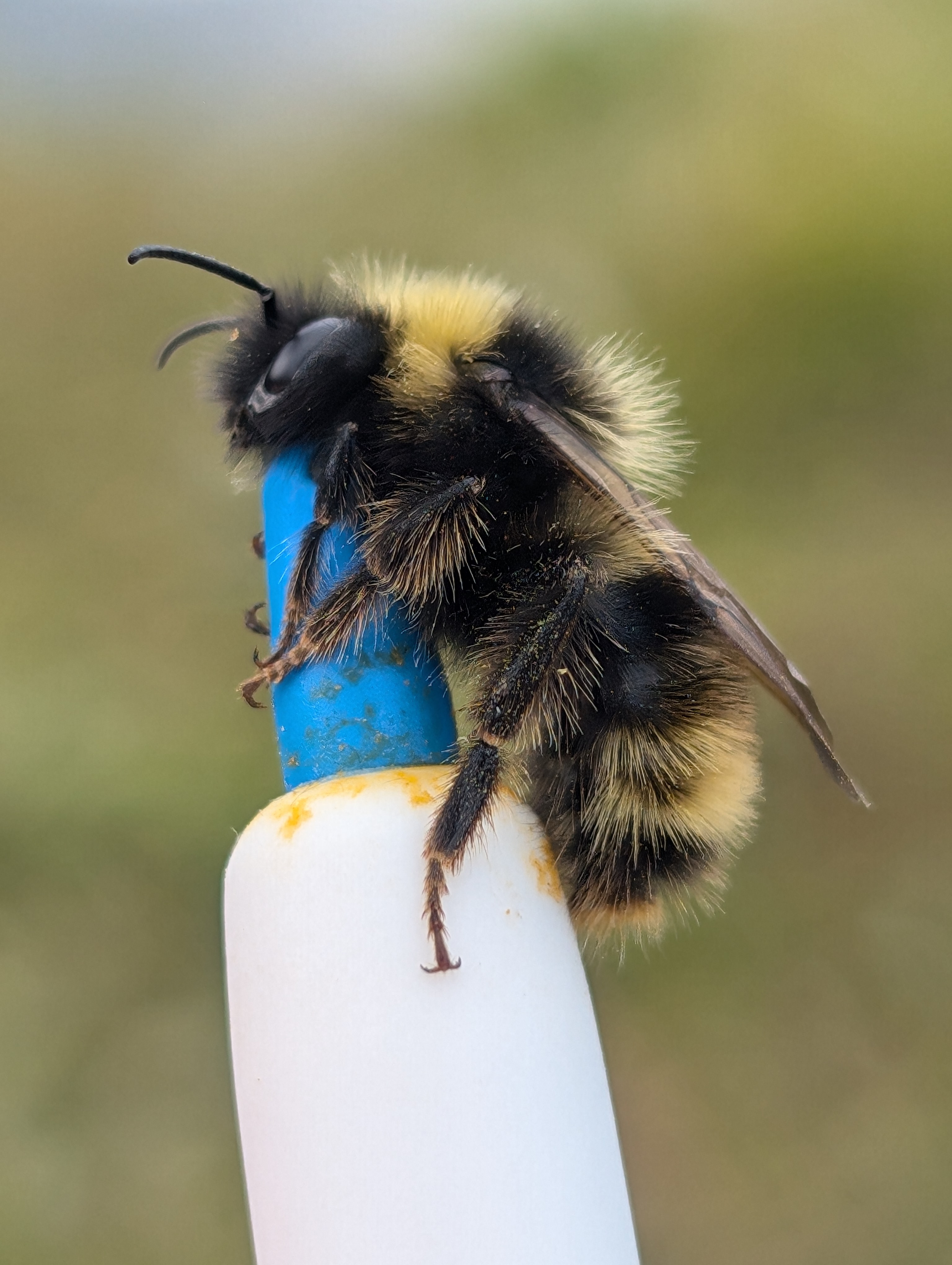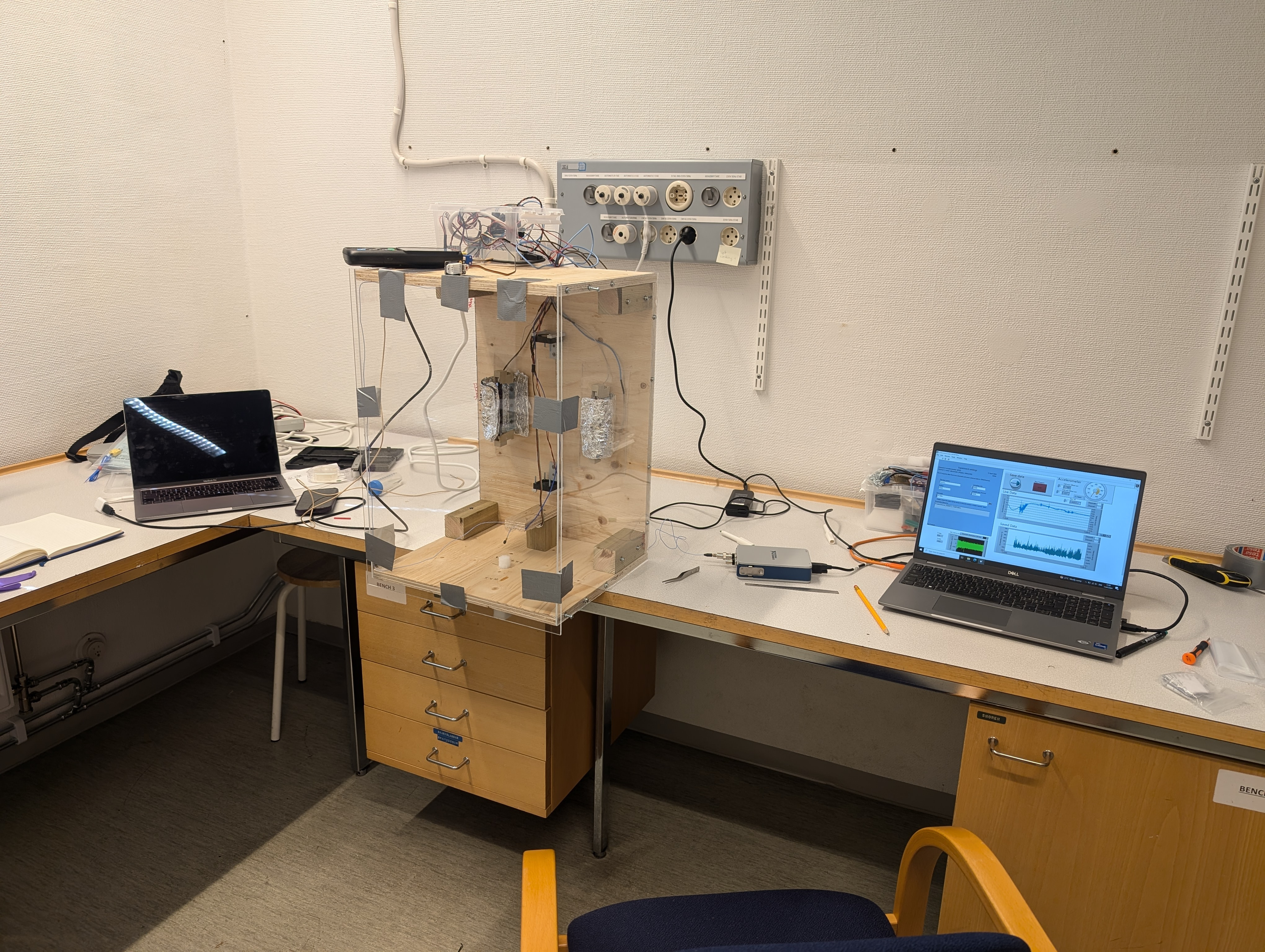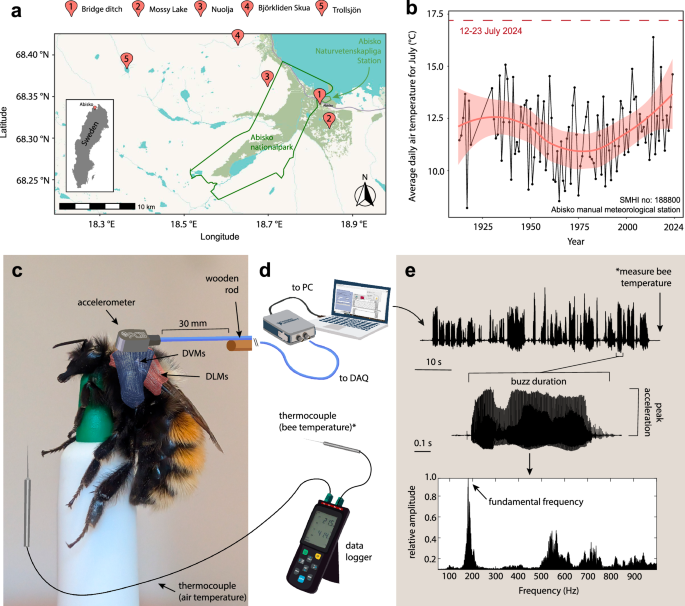How does temperature affect non-flight bee buzzes?
Published in Earth & Environment, Ecology & Evolution, and Plant Science

Why study a bee’s buzz?
The buzz of a bee is perhaps one of their most charismatic traits, and increasingly being used to understand insect flight physiology, biomechanics, and for training AI algorithms for acoustic monitoring of bee populations. Buzzes are produced by the primary flight muscles, which indirectly drive the motion of the wings during flight through cyclic deformation of the thorax. Changes in wing size, body mass, and temperature are known to affect the functioning of these muscles during flight. However, these muscles also produce buzzes in many non-flight contexts, including communication, defense, and buzz pollination, where temperature effects are unknown. Understanding how non-flight vibrations vary with temperature can help us to understand the ability of bees to effectively communicate, defend themselves, and pollinate with future climatic changes; and provide broader insights into insect flight muscle biomechanics.
In this study, we aimed to understand how changes in temperature affect non-flight buzz behaviour and biomechanics. We chose as our model system for this research the diverse bumblebee community of the Arctic, which are experiencing disproportionately higher rates of temperature change compared to lower latitudes - a phenomenon known as Arctic amplification. We suspected that the cold adaptations of these high latitude species may make this an interesting comparison to our lab reared bumblebees in the future, which enjoy warmer greenhouse environments. While our motivation was rooted in understanding the effect of temperature changes on buzz pollination behaviour (whereby bees grasp flowers and use vibrations to elicit rapid pollen release), the low occurrence of buzz pollination events in the field made this direct measure challenging in our short field season. Instead, we therefore focused our efforts on defensive buzzing, which is considered in some regards a good proxy of buzz pollination performance, and permits much more rapid data collection.
Using both field experiments and ‘field-based’ lab experiments (with a portable temperature controlled chamber we transported to the field station), we characterised thorax biomechanics by placing an accelerometer against the thorax of the bee and inducing defensive buzzing (Figure 1). As the bee buzzes, the accelerometer is displaced, and from this data we can extract the amplitude, pitch, and duration of buzzes from the thorax directly, and then test how this differs across species, castes (worker, queen, or drone), and temperature.

Figure 1. Bees were held with modified tick removers to allow for easy restraint.
Measuring biomechanics in the field and lab
Our aim to measure the biomechanics of thorax vibrations in the field was a technical challenge, mostly because of the long hikes and requirement for external power sources to keep the laptop running. Our longest hike was a 2 hour uphill climb to Trollsjön Lake, close to one of the few localities of some of the more elusive species. Once at location, our setup involved finding a flat surface to set out all the equipment while the team started netting bees (Figure 2). In these field experiments, across five locations, we were able to survey 15 Bombus species, with all caste representatives for six of the more common species. This generated a dataset of over 6,000 defensive buzzes. Arguably our most exciting measurements came from some of the largest bumblebees in Northern Europe; Bombus hyperboreus and B. balteatus. One queen of B. balteatus had a thorax acceleration peaking at over 150 g! For workers and drones of each species, we measured the temperature of the thorax after buzzing to understand the relationship between buzz biomechanics and muscle temperature. The temperature of the thorax in field experiments was found to be much higher than environmental temperature, peaking at 44 °C and similar in range to studies in commercially reared bumblebees. It was interesting to find that there was no evidence for species or caste differences in buzz biomechanics with temperature.
.jpg)
Figure 2. Equipment positioned in the field ready to take measurements.
In the lab, we aimed to expand our range of air temperatures to better capture expected thermal performance curves of non-flight buzzing behaviour. We brought to the field a portable temperature controlled chamber (Figure 3), which we used to set a range of air temperatures from 5 to 35 °C and measure defensive vibrations of the four most abundant species without the noise of the field environment. From these experiments, we added a further 8,500 buzzes to our dataset and then tested for differences in lab and field datasets before describing thermal performance curves. From these experiments, we observed some interesting trends in muscle biomechanics with temperature. In general, we found that the properties of the buzz were very well explained by thorax temperature (and even more so after accounting for body size), while the air temperature relationships were present but weak. This highlights a core issue with using air temperature as an indicator of muscle performance in bumblebees - their endothermy.

Figure 3. Portable temperature controlled chamber set up in the field station lab.
As for the relationships themselves, we found that increasing thorax temperature led to increasingly higher frequency (pitch) buzzes. This effect is almost certainly a result of increased reaction rates in the activation of these muscles, changes in thorax stiffness, or a combination of the two. The range of frequencies was also incredibly broad, from 100 - 400 Hz, increasing at a rate of approximately 10 Hz/°C. For the amplitude of buzzes (measured as acceleration), we found that the best thorax temperature for peak amplitude was very high, at 40 °C, while the best air temperature was a more modest 25 °C. This is similar to the peak performance of commercially reared bumblebees, which surprisingly led us to conclude that, at least for this dataset, Arctic bumblebees do not appear to differ in their buzzing thermal performance to any other bumblebees. If this finding is consistent across future experiments, it may optimistically suggest that Arctic bees will have some tolerance in their buzzing behaviour as our global climate warms. Although we prefer caution in this statement, as many other aspects of bumblebee behaviour and physiology may be negatively affected by a warming Arctic. More thorough measurements of thermal performance of warm adapted bumblebees using the same methodology would be beneficial in better understanding this observation.
Conclusions
If we want to understand what determines the properties of bee buzzes, particularly for use in training AI for bioacoustic species detection and for studying the drivers of specific buzzing behaviours such as buzz-pollination, temperature measurements are essential. While our study has made a start in connecting temperature to thorax biomechanics, further work is needed to test the strength of the conclusions made from our data, and to work towards a better understanding of bee thermal biology. More generally, the field would also benefit from:
- Non-invasive methods such as thermographic imaging for continuous temperature tracking and to avoid the need for lethal methodologies.
- Measures of metabolic rates across different temperatures and buzzing behaviours to connect temperatures and behaviours to an energetic cost.
- Further simultaneous temperature and buzz measurements across diverse bee taxa, particularly those in warm tropical and arid climates.
- Comparisons of thermal performance of defensive and buzz-pollination buzzes, to understand whether these temperature responses can be generalised across thoracic muscle functions.
Follow the Topic
-
Nature Communications

An open access, multidisciplinary journal dedicated to publishing high-quality research in all areas of the biological, health, physical, chemical and Earth sciences.
Related Collections
With Collections, you can get published faster and increase your visibility.
Clinical trials 2025
Publishing Model: Open Access
Deadline: Dec 31, 2025
Women's Health
Publishing Model: Hybrid
Deadline: Ongoing





Please sign in or register for FREE
If you are a registered user on Research Communities by Springer Nature, please sign in